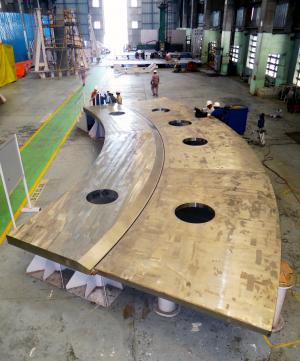Keeping it cold
For keeping your coffee warm, there's nothing like a thermos—an ingenious and simple device invented at the end of the 19th century. In between the two walls of a thermos, a vacuum provides the thermal insulation that keeps your hot drink hot.

And what works for the high end of the thermometer also works for the low—a chilled liquid, insulated from the external environment by the thermos' vacuum, will also conserve its temperature for several hours.
In the ITER Tokamak, the conservation of cold is essential for ensuring the superconductivity of the magnet system, which is cooled to -269 °C through the circulation of liquid helium (see ITER Mag #5). If this extraordinarily low temperature—colder than the environment of Pluto—isn't maintained, the ITER magnets would lose their superconducting properties and plasma operation would be brought to a halt.
To succeed, the magnet system must be isolated, as perfectly as possible, from the surrounding environment. How? By placing the machine and its magnets within an enormous thermos—a cylindrical vessel called the cryostat that measures 30 metres in height and as many in width.
Between the liquid helium circulating inside of the magnets and the tokamak environment, the difference in temperature is approximately 300 °C. This large temperature gradient is reduced by installing an intermediate thermal barrier—called a thermal shield—at a distance of about ten centimetres from the magnets. The ITER thermal shield will be actively cooled to -193 °C. A vacuum about one million times less dense than the air we breathe insulates the thermal shield from the cryostat, preventing thermal exchange between the two environments.
With a total volume of 16,000 m³, the ITER cryostat is not only one of the world's largest vacuum chambers¹, it's also by far the most complex.
Unlike a thermos, whose surface is never breached, the ITER cryostat will have some 280 penetrations—certain as large as four metres—which will provide access for piping, electricity, heating systems, diagnostics and remote handling systems. Each one of these openings will have to be as leak-tight as possible to preserve the cryostat's vacuum environment.
But the leak-tightness of joints and bellows is not the only challenge. In certain temperature conditions materials tend to "outgas"—that is, to liberate a small quantity of their constituent molecules. The quality of the vacuum is affected little by little by this outgassing and powerful cryopumps² are needed for the regular evacuation of these molecules.
Beyond its insulating role, the ITER cryostat also has a structural function to fulfil in ITER. "The cryostat is joined mechanically to the ITER machine and in this way is part of a structural assembly," says Igor Sekachev, the engineer responsible for the ITER cryostat. "The concrete and steel pedestal that has been designed to support it was sized for a total mass of 23,000 tons—the 3,850 tons of the cryostat itself as well as the 18,900 tons of the vacuum vessel, magnet system and thermal shield."
Larsen & Toubro, the Indian company that manufactured the rocket, antenna and radar of the Mars Orbiter Mission Mangalyaan, began the fabrication of the ITER cryostat in early 2014. The first segments of this enormous cylinder, made from steel from the forges of Industeel-Le Creusot (see article in this issue), will be shipped from the factory in September 2015.
From 54 segments, the four principal sections of the cryostat will be welded and assembled in an on-site facility that was inaugurated in 2014.
The assembly of the ITER Tokamak will begin and end with the cryostat: the base section of the cryostat will be the first large component installed in the Tokamak Pit and the top lid of the cryostat (600 tons) will be the last large component, set into place after the installation of the vacuum vessel, magnets, thermal shielding and central solenoid.
(1) Only the NASA's Space Power Facility, built to re-create the high-vacuum environment in space for the testing of satellites and hardware, can boast a larger vacuum chamber (22,500m³). One of the most spectacular scenes of The Avengers was filmed there in 2011.
(2) Cryopumps are used alongside regular pumps at ITER to create a high vacuum in large-volume environments (vacuum vessel, cryostat) by "trapping" gaseous molecules in their intense cold.


